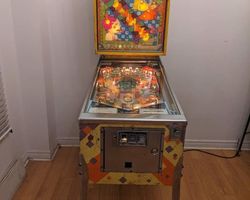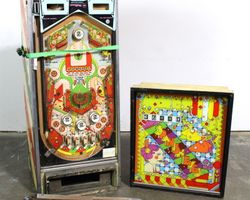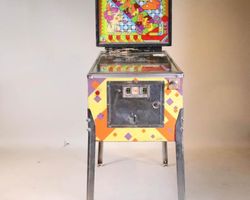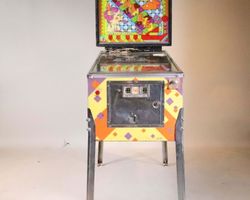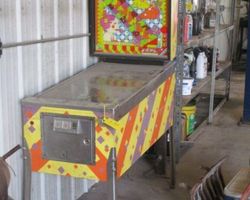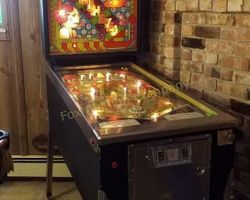Spanish Eyes
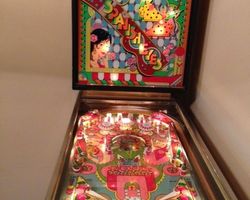
Average Prices: USD $200 to $900
Produced: November, 1971
Production Run: 3,905 units
Machine Type: Electro-mechanical
Players: 1
Design by: Norm Clark
Art by: Christian Marche, John Craig
The pinball machine "Spanish Eyes," released by Williams Electronics, Incorporated in March 1972, stands as a distinctive example of Electro-Mechanical (EM) era design. Manufactured as model 408, this single-player game emerged from a period of intense innovation in the pinball industry, with Williams continually pushing design boundaries.
History and Background
Williams Electronics, Incorporated produced 3,905 units of "Spanish Eyes," with an initial sample run in November 1971 before full production commenced in March 1972. The machine was designed by Norm Clark, a prolific figure in pinball development, known for his ability to craft engaging layouts. However, a significant part of "Spanish Eyes"'s identity stems from its unique visual presentation, brought to life by artist John Craig.
Craig's involvement with "Spanish Eyes" began serendipitously. Approached by Joe Mascheck, then an art director at Williams, Craig found himself sketching designs for a pinball machine. Though he admitted to not being drawn to the "Spanish Eyes" theme initially, the prospect of contributing to the burgeoning world of pinball was compelling. He ultimately received $1,000 for completing both the backglass and playfield artwork, with the cabinet art also appearing to be based on his designs. During this period, Craig was also illustrating for Playboy magazine, even contributing to an article focused on pinball machines. "Spanish Eyes" and its sister machine, "Granada," remain the only two pinball machines to feature Craig’s unique artistic vision. His experience offered a glimpse into the pinball production process, including a room where games with unadorned plywood playfields were tested by players paid to evaluate play appeal and identify issues.
Signature Features and Design
"Spanish Eyes" distinguishes itself immediately through its unconventional playfield layout, specifically the placement of one of its four pop bumpers. This particular pop bumper is situated directly between the two flippers, over the drain. This departure from conventional design significantly alters ball physics and player strategy, creating a truly unique playing experience. In addition, the machine lacks traditional slingshots and inlanes, features common to most pinball designs of the era. The pop bumpers themselves are DC-powered, providing a crisp, responsive action that contributes to the game’s dynamic flow.
The artwork by John Craig is a standout element, defining the machine's aesthetic. Craig’s style is characterized by stylized, blocky figures rendered in a vibrant, colorful palette, depicting scenes of dancing, music, and women that align with the Spanish theme. This distinctive visual approach imbues "Spanish Eyes" with a character that sets it apart from many of its contemporaries, becoming a key aspect of its identity.
Playfield and Mechanics
The playfield of "Spanish Eyes" is organized to emphasize direct shots and unpredictable ball movement. At the top, three pop bumpers and a series of roll-over lanes encourage initial ball interaction and scoring. Below this section, six numbered standup targets are positioned, which players must hit to advance their score and potentially earn awards. A kick-out hole and a horseshoe lane offer additional distinct targets, requiring precision shots to activate.
The central and lower playfield areas are where "Spanish Eyes" truly diverges from typical designs. The absence of inlanes means that balls exiting the top of the playfield or bouncing off targets often move quickly and directly towards the flippers, or, crucially, towards the pop bumper positioned above the drain. This central pop bumper is the linchpin of the playfield’s design philosophy, ensuring a highly dynamic and often unpredictable ball path. Its placement transforms what would typically be a direct path to the flippers into a chaotic zone, demanding constant player attention and nudging skill. The colorful, stylized artwork by John Craig visually complements this vibrant, yet challenging, layout, framing the various targets and lanes with a distinct aesthetic that enhances player immersion in the machine's Spanish theme.
Gameplay Dynamics
"Spanish Eyes" presents a gameplay experience focused on skill, reaction time, and adapting to a constantly shifting ball. The primary objectives revolve around accumulating points and completing specific target groups. Players aim to complete the series of six numbered standup targets and to navigate the ABCDE lanes positioned across the upper playfield. Successful completion of these objectives often awards the "Special," which can be configured for extra balls, replay, or novelty play, with the "add-a-ball" feature being particularly valued for extending play sessions.
The game also incorporates skill shots, adding an initial challenge to each ball launch. However, the most defining gameplay mechanic is the interaction with the pop bumper situated between the flippers. This feature creates a high degree of unpredictability; a ball heading for a seemingly safe drain can suddenly be propelled back into play, or, conversely, a well-placed shot might be deflected into an immediate outlane. This element necessitates constant nudging and precise flipper work, transforming what might appear to be a simple EM layout into a demanding exercise in ball control. The game rewards players who master these techniques, offering dynamic, varied, and fast-paced rounds that demand continuous engagement.
Reception and Legacy
"Spanish Eyes" has garnered a range of opinions within the pinball community, cementing its reputation as a machine that polarizes players. Its strengths are frequently cited as its unique gameplay and challenging nature. The unconventional layout, particularly the pop bumper positioned over the drain and the absence of inlanes, is often praised for creating a dynamic, unpredictable flow that sets it apart from other EM machines. Players who appreciate a high-skill, nudging-intensive game often find "Spanish Eyes" rewarding. The "add-a-ball" feature is also consistently highlighted as a strong positive, offering a clear objective and extending gameplay, adding considerable appeal. The DC-powered pop bumpers contribute to a lively playfield, enhancing the overall experience. While divisive, John Craig’s unique, blocky, and colorful artwork also has a dedicated following who appreciate its distinctive character and how it complements the machine's theme.
Conversely, the artwork is also the most common point of contention, with some players finding it aesthetically unappealing or even "bizarre." This subjective response to the visual design can be a significant barrier for some. Gameplay criticisms sometimes point to the machine’s inherent difficulty, with the unpredictable ball behavior from the central pop bumper occasionally leading to quick and frustrating drains for less experienced players. Some also find the game's rules and objectives to be straightforward, lacking the deep progression found in more complex designs. The minimal sound package, typically a single chime, is another minor point of criticism, seen as weak compared to more elaborate audio designs.
Despite these divisions, "Spanish Eyes" holds a noteworthy place in pinball history as a testament to Williams' willingness to experiment with fundamental playfield layouts during the EM era. It stands as an example of how a single design choice—the central pop bumper—can drastically alter gameplay dynamics and player interaction. While it may not have directly influenced many subsequent designs, its distinct characteristics ensure its ongoing discussion among collectors and enthusiasts, highlighting the breadth and variety of pinball machine design from a pivotal period in the industry.
Sponsored Links
 Ebay Listings
Ebay Listings
 Auction Results
Auction Results
| Cost | Location | Date |
|---|---|---|
| CAD $390 |  Canada Canada |
28 July, 2025 |
| USD $175 |  Maryland, United States Maryland, United States |
26 June, 2025 |
| USD $83 |  Tennessee, United States Tennessee, United States |
04 December, 2024 |
| USD $700 |  South Carolina, United States South Carolina, United States |
15 September, 2024 |
| USD $306 |  Minnesota, United States Minnesota, United States |
20 February, 2024 |
| USD $1,595 |  United States United States |
06 February, 2024 |
| USD $750 |  Kansas, United States Kansas, United States |
04 July, 2023 |
| USD $110 |  Illinois, United States Illinois, United States |
16 September, 2022 |
| USD $130 |  New Jersey, United States New Jersey, United States |
24 March, 2022 |
| USD $450 |  New Jersey, United States New Jersey, United States |
28 October, 2021 |


Private Policy · Search Website · Contact Us
As an eBay Partner, we may earn a commission from qualifying purchases made through links on this site, at no additional cost to you.
All trademarks and copyrighted materials remain property of their respective owners. All other content copyright 2007 - 2025 Pinpedia.

